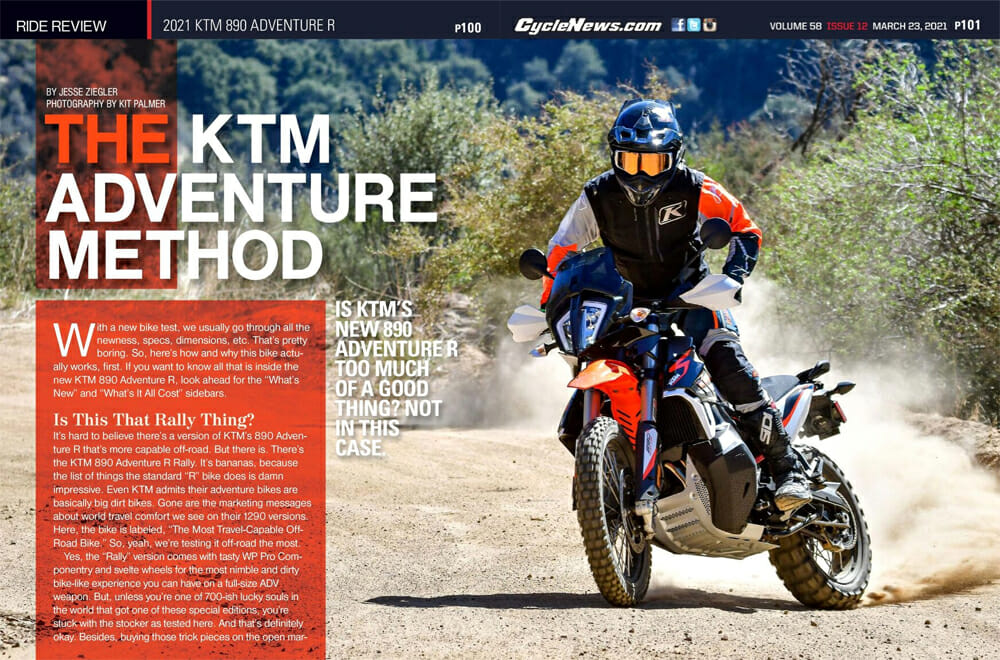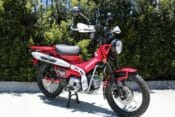With a new bike test, we usually go through all the newness, specs, dimensions, etc. That’s pretty boring. So, here’s how and why this bike actually works, first. If you want to know all that is inside the new KTM 890 Adventure R, look for the “What’s New” and “What’s It All Cost” sections at the end of the article.
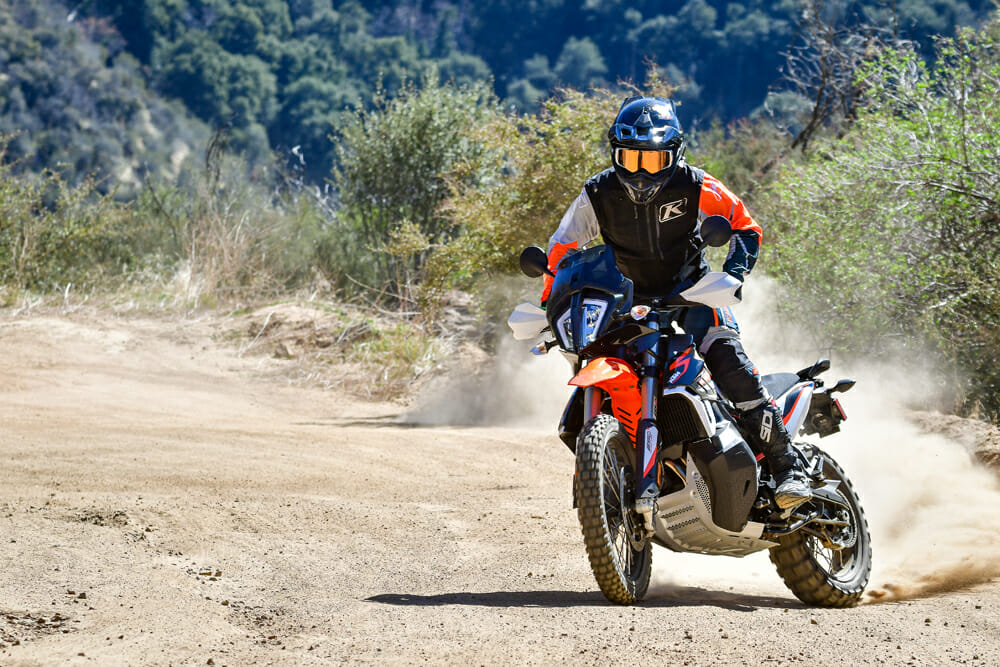
Photography by Kit Palmer
Is This That Rally Thing?
It’s hard to believe there’s a version of KTM’s 890 Adventure R that’s more capable off-road. But there is. There’s the KTM 890 Adventure R Rally. It’s bananas, because the list of things the standard “R” bike does is damn impressive. Even KTM admits their adventure bikes are basically big dirt bikes. Gone are the marketing messages about world travel comfort we see on their 1290 versions. Here, the bike is labeled, “The Most Travel-Capable Off-Road Bike.” So, yeah, we’re testing it off-road the most.
Yes, the “Rally” version comes with tasty WP Pro Componentry and svelte wheels for the most nimble and dirty bike-like experience you can have on a full-size ADV weapon. But, unless you’re one of 700-ish lucky souls in the world that got one of these special editions, you’re stuck with the stocker as tested here. And that’s definitely okay. Besides, buying those trick pieces on the open market is more than possible. And coming from someone who has ridden/raced a “Rally” equipped 790 Adventure R rather irresponsibly, it is something you should pursue with rapidity if your bank account/spousal arrangement will allow it. That’s a different story. Today we’re talking about the bike you can probably find at a dealership today.
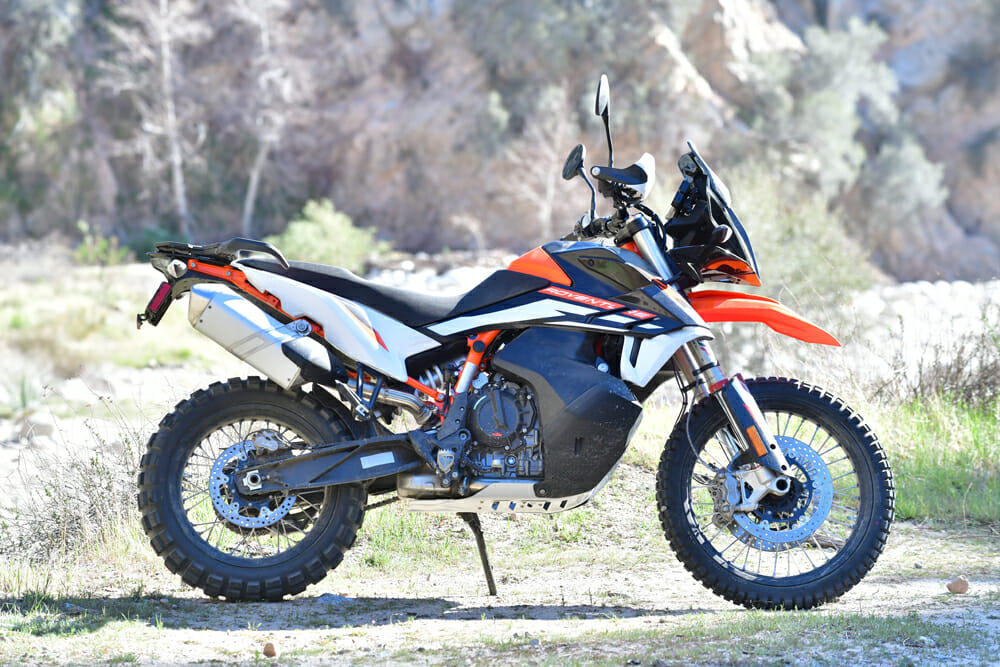
What’s The Big Deal With These KTM Adventures?
A lot of people ask me what’s so good about this platform of KTM ADV machines and I usually tell them it’s mostly about balance. It’s function to the core. And this bike oozes intent of design.
The KTM 890 (formerly 790) Adventure R enjoys the most stable and smartly weight-distributed chassis design on the market. This construct puts the majority of the most awkward, fluctuating, and most influential weight aboard the motorcycle (the fuel) at ankle level. This lowers the bike’s center of gravity so effectively, the bike feels magical in comparison to bikes with tanks on top of their frames/engines, etc.—essentially every other adventure motorcycle. It’s a distinct advantage.
From there, superb suspension manners and ergonomics take the wheel and finish the job delivering a sublime ride. It’s massively predictable, directionally influenced with minimal effort by the rider, encouraging in all terrain and continues to serve as the benchmark for motorcycle handling in the full-size ADV world. This goes for whatever engine size is slapped in the frame. Once you step on the pegs and set off, you will feel the bike working very, very well. The difference between how the KTM 890 Adventure R handles and other bikes in this class is substantial.
If you take a look at any competitive rally racing motorcycle from any manufacturer, you can clearly see a trend of holding fuel down low. Their two-sided tanks bulge at the bottom, creating volume as low as possible for fully fueled full-throttle floggings through timed sections across Saudi Arabia. This weight distribution is vital for handling performance. Carrying fuel is a necessity, so why not make it as comfortable as possible when things get uncomfortable and use it to improve handling? Tesla cars don’t have the batteries on the roof for a reason.
KTM embraced this with the launch of the 790 lineup and took inspiration straight from their employed racing lunatics competing in the Dakar Rally. They knew if they could get the fuel range on this bike to not hinder the handling, they would be on the way to winning, and they did. If you can get 200-plus miles of range and not feel it, you’re doing fine. KTM is doing fine.
The tank doesn’t look that sexy with the headlight fairing gap just sort of hanging out there, but they work brilliantly.
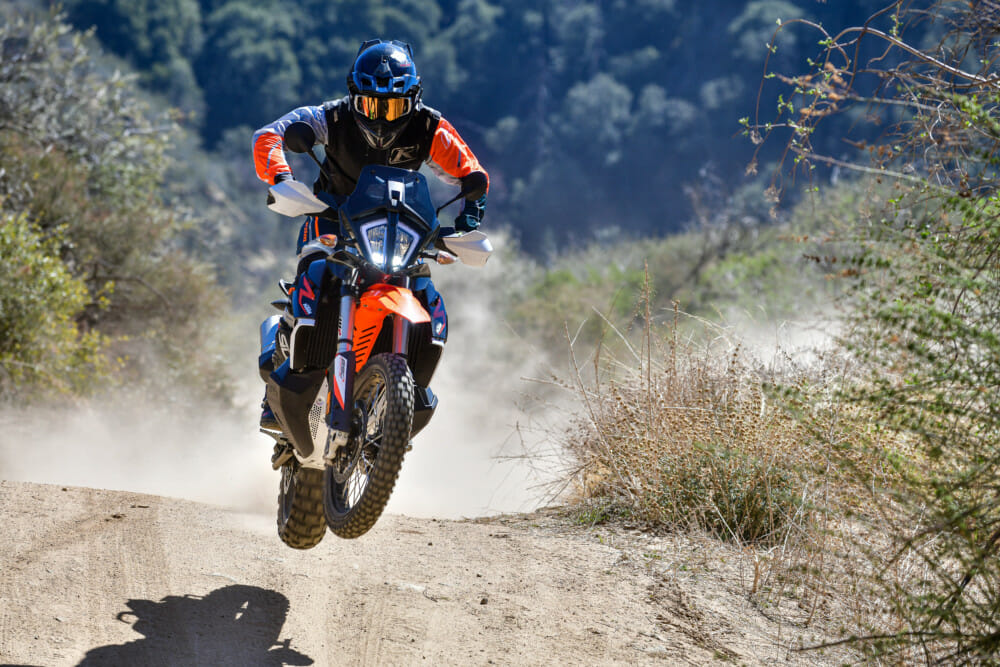
The Computers Have Taken Over
The boo-birds of rider aids on motorcycles are almost out of breath. And the KTM 890 Adventure R is here to suffocate the last notes from the ADV world. KTM’s updated Cornering Motorcycle Traction Control is a better version of a great system. Its improved reaction time in calculating mitigation is clean and effective. It has separated wheel-slip and vehicle-pitch sensing into independent controllers, spreading the work to more workers, as it were.
Without cutting ignition, KTM’s MCT intervenes at the throttle bodies in a more natural way to limit rear-wheel slip (by closing the throttle) that has been fine-tuned to be nearly unnoticeable. Rally Mode (installed as optional equipment as tested) provides nine selectable levels of slip allowance with nine being the mellowest. It’s the way to ride this bike off-road, as it also allows for more wheelspin in sand, say, to get you rolling in the deep.
Ride Modes are easy to over-simplify but there’s actually a lot going on behind the scenes of Street, Rain, Off-Road and Rally (if installed). Here’s an example: Off-Road mode allows more rear-wheel slip than Street, for instance, but also reduces overall power availability and smooths out the throttle response so you’re not all Brad Binder out there. Also, anti-wheelie control is turned off so you can Chris Birch right over that log, you badass! Finally, Off-Road mode ignores lean-angle sensitivities so when you rail a berm ala Cooper Webb or slice a dune like Toby Price on your sweet 890, traction control won’t think you’re crashing (even though you probably are about to tip over) and limit wheel slip, thus ruining the epic roost you were about to turn around to look at.
As you can imagine, the other modes are similarly programmed. Street gives you full beans, limited slip, punchy throttle response. Rain softens power, negates most slip and makes throttle response icy calm. You know what Rally does? It rules. That’s what it does.
KTM’s Cornering ABS gets updated software specs and a cleaner activation to reduce feel of intrusion to the rider. The Off-Road ABS disables rear-wheel ABS completely and allows slides and rear-wheel control without limit.
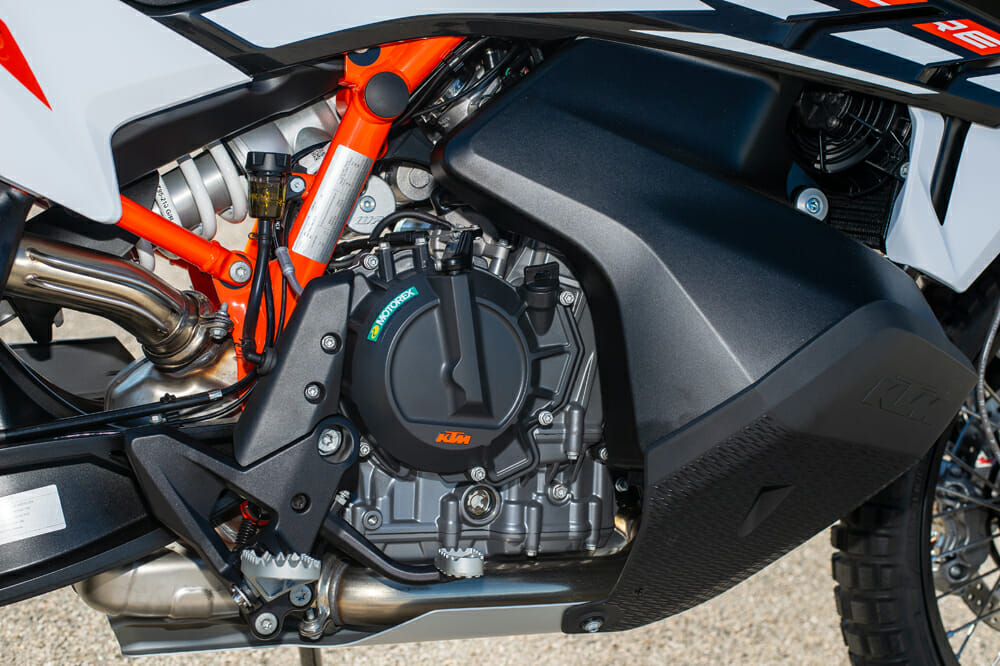
Handling It All
The KTM 890 parallel-twin engine deserves some credit in all this balance talk, too. It’s aligned cylinders and the moving bits inside do little to throw the bike’s balance off despite rowdy attempts to repeatedly do so. The bike likes to go straight, and it likes to go straight quickly. But it will also moto-turn, enduro mob, or grass track with the best of them and drift like a champ across gravel roads. Unlike its v-twin cousins, this twin behaves at some pretty amazing angles.
In addition, enough cannot be said about KTM’s WP Xplor 48mm fork on this bike. The action and compliance are top-notch with bottom-out control off-the charts for a 500-ish-pound machine. I jump adventure bikes fairly often because, when the opportunity presents itself, why not? But none of them really make me want to look for jumps. This one does! I pray for road-erosion-control berms in my direction when I hit a new dirt road on this bike. Generally, landing an ADV bike is an experiment. Here, it’s proven science with bottom-out worries banished from your concern. It is absolutely controlled. It might be too confidence-inspiring.
Aiding the control confidence, stiffer steering-stem material keeps front end connection to the ground insanely tight. The new aluminum steering tube feels like it has zero flex, pushing the front tire where you want it with sharp precision at the sacrifice of a bit of small-bump compliance, maybe. A tradeoff worth it if you need to count on your front-tire footprint being on the right side of a rock or root, for sure. But if you’re pounding washboards all day, you might want to mute that edge somehow.
One of the only negative-handling traits carried over on the 890 from the 790 platform is a bit of high-speed sandwash headshake that can sneak up on you. The standard stabilizer doesn’t muffle it, but bolting on an off-road racing stabilizer has proven effective in the past. Otherwise, don’t trust this bike to do bomb runs without a little shimmy excitement. Also, take some time dialing in ride height/preload on the shock for your weight and cargo. The PDS shock system is simple and effective but if you get outside a usable range of rider sag, you can start chasing rebound to slow the back end down from kicking over bumps.
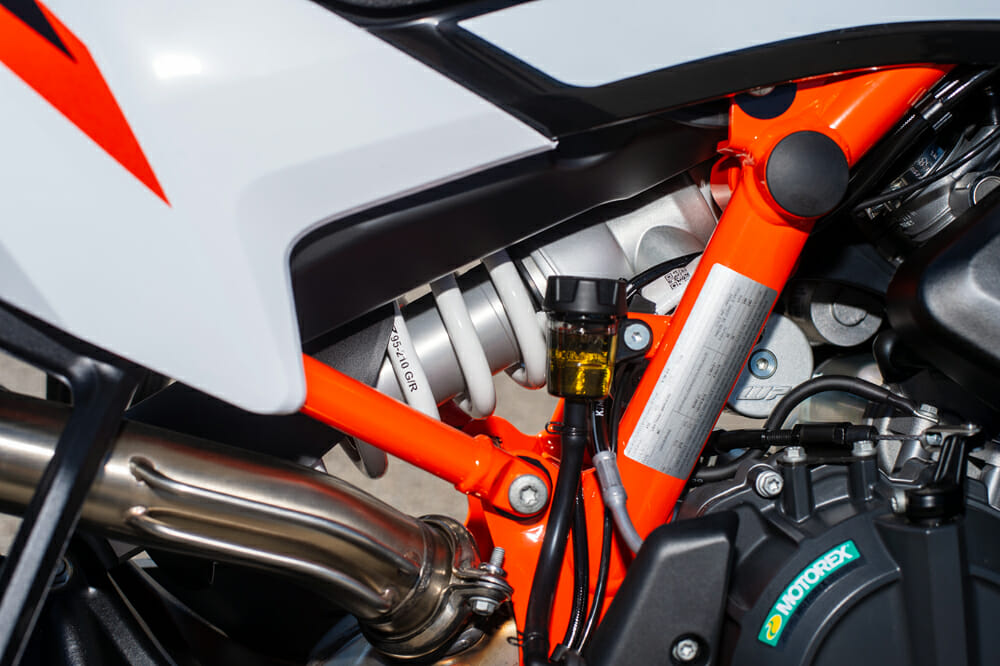
890!
Now, for 2021 KTM has chiseled out their 790 to an 890 with an actual increase of 90cc. Why? Because the world is moving forward with increasingly restrictive emissions regulations and to stay on top of performance benchmarks for what they consider acceptable, KTM is willing to make more displacement happen immediately. The benefit is a cleaner engine for the future and more ADV-friendly power delivery for right now. You are seeing this trend across all regulated motorcycles. You will see more.
What’s a bit odd here with all this addition to displacement math is that we’re nearly exiting the “middleweight” class and back into liter-bike territory. Didn’t the internet want a 700cc KTM twin to start with? Maybe something to pounce through the forest with the growly Tenere 700? Maybe, but what we have now is 890cc of awesome.
More torque is on tap with the 890 and that’s a welcome addition to a bike that feels like it should be used to move massive amounts of earth. The 890 engine is great. Nearly perfect for adventure use, with road manners to push you to the next exploration zone/continent with ease. It behaves so well off-road and shines on the tarmac that you might wonder why you thought smaller could be better.
More than just bigger and longer holes in cylinders, the engine also has increased flywheel effect thanks to heavier rotating mass at the crank (20% heavier, claimed). This smooths power delivery and makes traction, to put it bluntly. More power. More torque. More traction. I’m more sold.
This motor is more than a near future-proof choice. It just feels better than a 790 with a power delivery harmonizing with the balance of the chassis better than ever. The 790 could get a little chunky down low as it looked for momentum between piston peaks. But the 890 churns through low-speed corners with a healthy mass. Open it up and that mass turns into traction and grunty acceleration—the best feeling in the world.
890 Adventure R buyers will enjoy the upgraded engine and running changes, like additional oil jets to cool pistons, new connecting rods and pins, a revised clutch assembly with new friction plates and more cooling to correct a rare weak spot in the 790’s armor.
KTM even addressed the 790’s Achilles heel of rear-brake fade/overheating with an updated stainless brake hose, new isolated rear-brake pistons and isolation plates between pads and pistons—all in an effort to combat heat buildup out back.
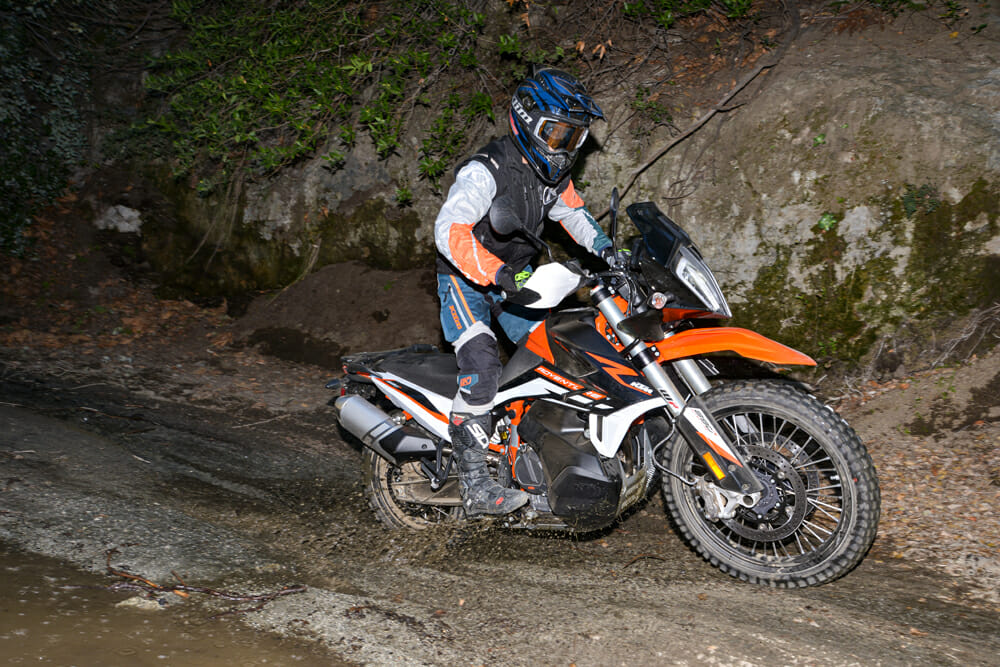
Does it look cool?
Aesthetically polarizing, The KTM Adventure 890 family simultaneously hits and misses the rally-style marks for many, myself included. The tank and seat, shrouds, subframe and more look like more than a street-bike-turned-ADV machine, but the headlight assembly needs some help to finish the roadbook-inspired look and separate this bike from the Duke family of on-road rippers.
Despite a few style point deductions for some, the KTM 890 Adventure R’s badassery is not in question. You can’t ride one of these and expect much more than KTM already boldly claims… unless you’ve ridden a long-travel Rally version. Then you’ll want all that, too. CN
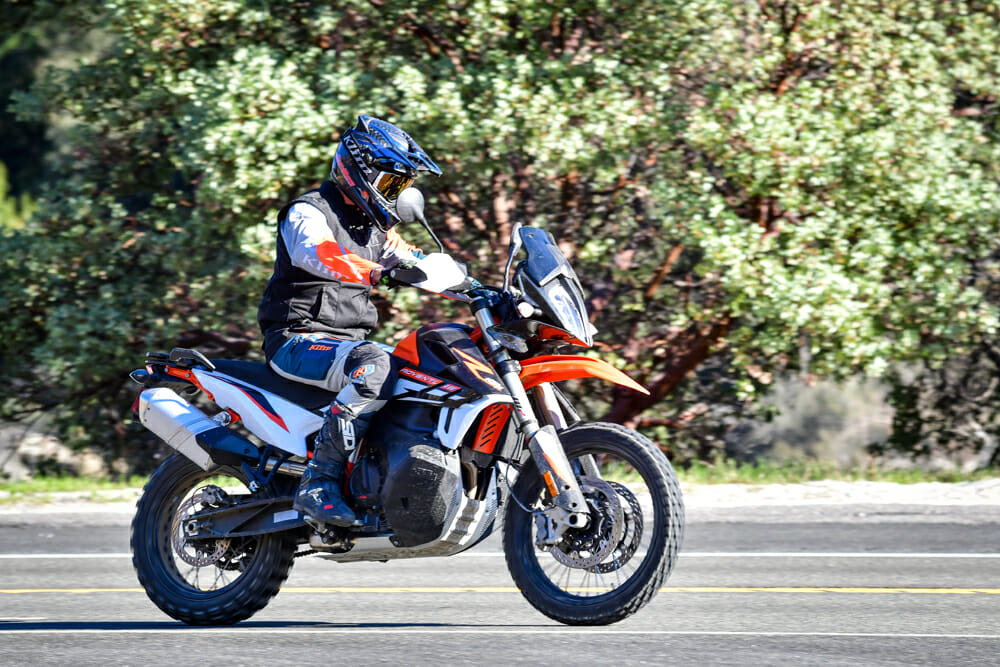
What’s it all really cost?
The bikes we test are very perfect. They are prepped by the in-house KTM media team, they have the latest updates and software installed if available, and in the KTM 890 Adventure R’s case, they have all the dealership-enabled options activated so we can test the full functionality. Save for heated grips and other accessories, this is a loaded model. Here’s what it cost as tested with all available options turned on and set up:
KTM 890 Adventure R MSRP: $14,199
+ Freight: $550
+ PDI at the dealership: $400
+ Rally Pack (includes Quickshift, etc. etc.): $500
What’s New With The KTM 890 Adventure R
On the surface, you could easily assume the 890 era of KTM’s Adventure legacy is simply a displacement bump for good old-fashioned fun. But, as we’ve seen with the nimble Austrian plant, producing running changes is part of the program if there’s something to improve. With the KTM 890 Adventure R, there are significant updates from the previous 790 family. Here’s everything new.
Engine
- 889cc, 90.7mm bore x 68.8mm stroke
- 13.5:1 compression
- 1mm larger intake and exhaust valves, higher valve-spring rates and steel springs
- Forged box three-ring pistons, shorter piston pin, 10 grams lighter than 790 pistons. Two oil jets per piston for cooling
- Two new balancer shafts to complement larger engine performance. One in front of the crankshaft and another in the cylinder head.
- V-shaped connecting rods have less oscillating mass. Top-end bearing bronze conrod instead of DLC coated
- New high-pressure aluminum cast horizontally split crankcases. Weight optimized via wall thickness attention. Open deck cylinders are fully integrated
- Updated Power Assist Slipper Clutch (PASC) with new friction plates and increased oil-flow cooling for higher durability with new engine
- Larger oil cooler
- Shorter shift-lever travel, improved settings of the optional Quickshifter+, updated gearbox with glass beading on 4th, 5th and 6th gear cogs
Chassis
- New, lighter subframe with consistent strength/rigidity
- Forged-aluminum steering stem and triple clamps
- Anodized wheel hubs instead of powder-coated
Brakes
- Stronger front-brake master-cylinder piston spring and new sealing technology provide more accuracy
- New isolated rear-brake pistons in the caliper and isolation plates between the pads and piston for more heat stability.
- Stainless-steel rear-brake hose/connection fitting
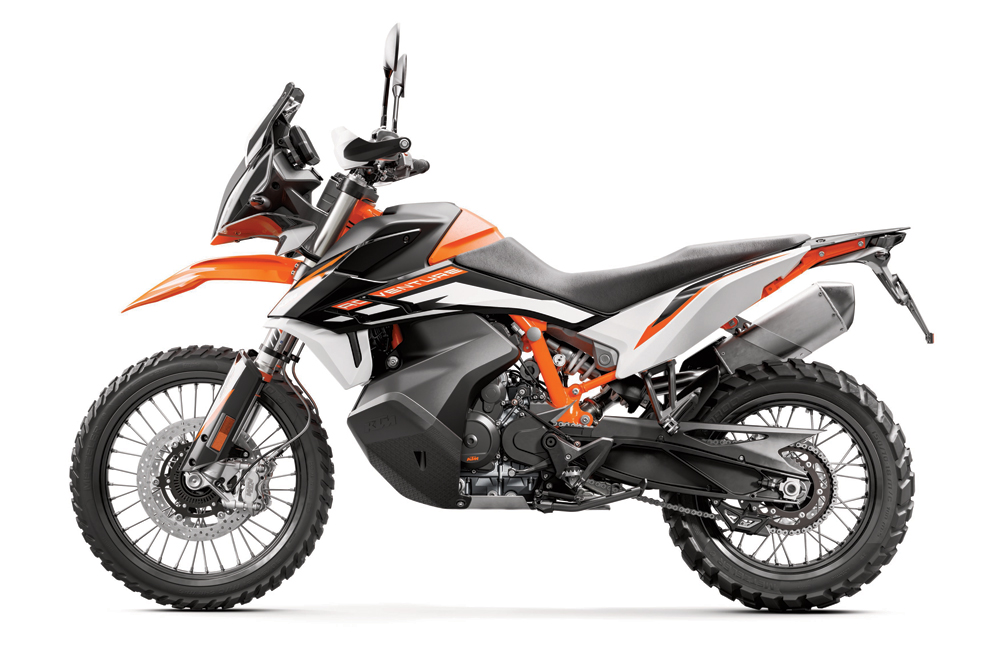
2021 KTM Adventure R Specifications
| MSRP: | $14,199 |
| ENGINE: | Parallel-twin |
| DISPLACEMENT: | 889cc |
| BORE x STROKE: | 90.7 x 68.8mm |
| VALVETRAIN: | DOHC, 8 valves |
| HORSEPOWER (claimed): | 100 hp at 8000 rpm |
| TORQUE: (claimed): | 74 ft-lbs at 6500 rpm |
| FUELING: | EFI Dell’Orto w/ 46mm throttle body |
| TRANSMISSION: | 6-speed |
| CLUTCH: | PASC assist-and-slipper clutch |
| FRAME: | Chromoly tubular steel w/ stressed engine; chromoly trellis subframe |
| HANDLEBARS: | Tapered aluminum |
| FRONT SUSPENSION: | WP Xplor, coil sprint, fully adjustable |
| REAR SUSPENSION: | WP Xplor, single shock, fully adjustable |
| FRONT-WHEEL TRAVEL: | 9.4 in. |
| REAR-WHEEL TRAVEL: | 9.4 in. |
| FRONT BRAKE: | Radially mounted 4-piston calipers, dual 320mm discs w/ ABS |
| REAR BRAKE: | 2-piston floating caliper, 260mm disc |
| FRONT WHEEL/TIRE: | Spoked, 90/90-21 in. Continental TKC 80 |
| REAR WHEEL/TIRE: | Spoked, 150/70-18 in. Continental TKC 80 |
| RAKE: | 26.3/26.2° |
| WHEELBASE: | 60.2 in. |
| SEAT HEIGHT: | 34.6 in. |
| FUEL CAPACITY: | 5.3 gal. |
| WEIGHT (dry, claimed): | 432 lbs. |
Click here to read the 2021 KTM 890 Adventure R Review in the Cycle News Digital Edition Magazine.
Click here for the latest Cycle News Adventure motorcycle reviews and news.
Click here for more KTM motorcycle reviews and news.
